The Tesla Cybertruck’s bare metal panels are unique compared to the painted panels of most automobiles. Now that the truck is in the hands of customers, you may have read all the stories about the rust issues, as people learn how to care for stainless steel, and how it behaves out in the elements. Questions have swirled around whether the Cybertruck can hold up to the weather, and just what stainless steel is really capable of. Let’s take the Cybertruck as a jumping off point, and explore the reality of stainless steel in more detail.
The hubbub right now is that a number of Cybertruck owners have reported seeing rust spots on their vehicles, in some cases just days after taking delivery. This set off alarm bells, with outlets rushing to cover the story. Dig down into the forum posts, and it’s easy to see why some owners were getting upset. One poster known as Raxar shared pictures of small orange-brown spots peppering the body, as did OnTheSnap. and Vertigo3pc had a similar experience after a rain storm in LA.
Nobody wants a six-figure truck that looks like a crappy Walmart barbecue left outside in the winter. As good as the name “stainless steel” sounds, we’ve all seen some cheap stainless steel appliances plagued by the orange-brown rot of corrosion. Does that mean the same fate awaits the Cybertruck?
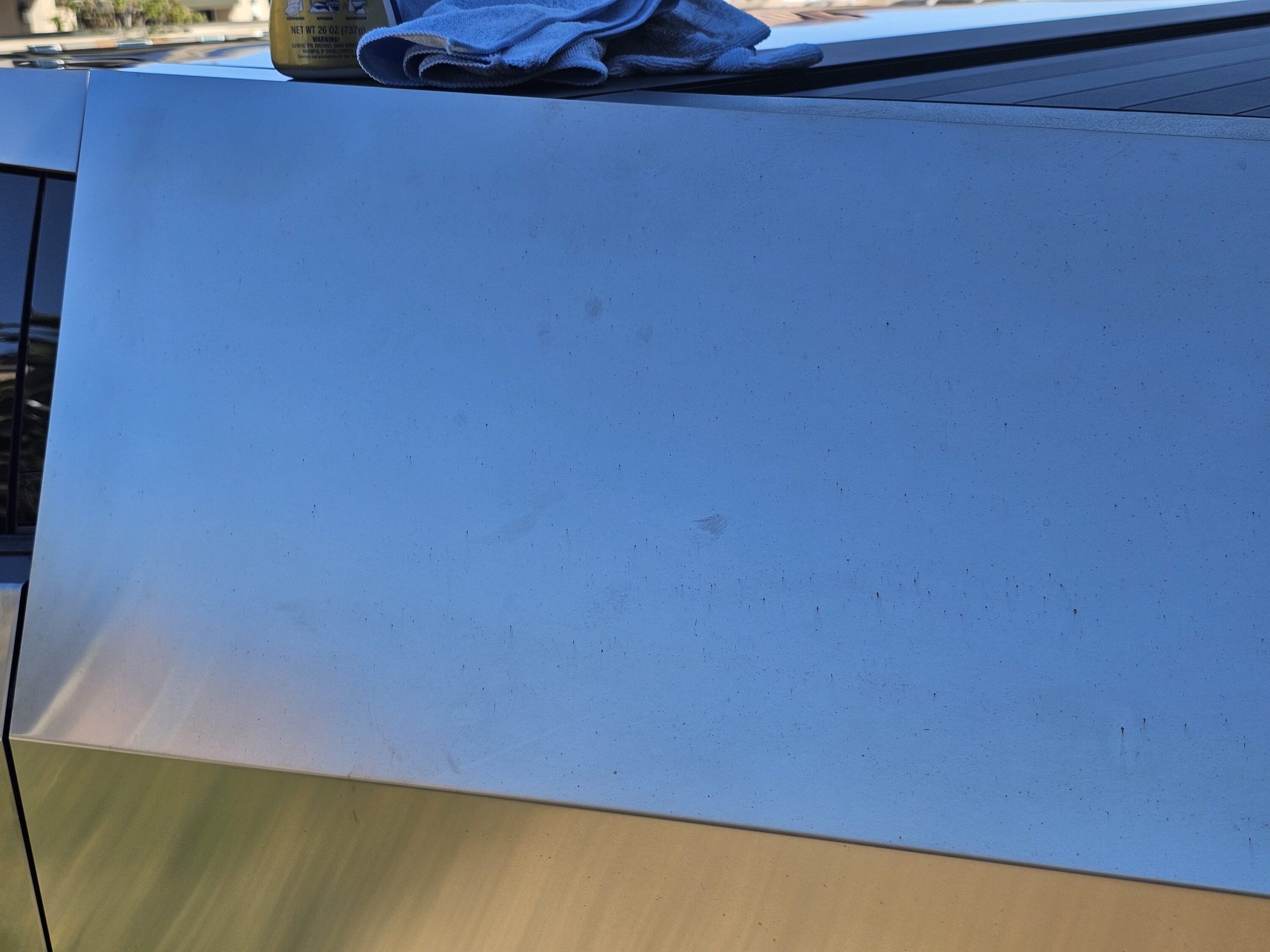


Speaking to The Autopian, vertigo3pc explained their discovery of rust marks on the Cybertruck. “I discovered the marks on my Cybertruck’s finish probably the fifth day I had the truck at home,” he explains, noting it was after a days-long rain storm in California. “I noticed the tiny spots on the right and left panels next to the vault.” The rusty-looking spots didn’t come off with the use of a clay bar, so he headed to the forums for answers. “I thought it was some sort of contamination, moreso than something sitting on the metal,” he says.
Multiple owners have since come forward to share similar photos of marks and rusty-looking spots on their new Cybertrucks. To understand what’s going on, let’s dive into some chemistry and see if learning about stainless steel can solve this problem.
Does Stainless Steel Rust?
Well, here’s where it gets complicated. Stainless steel is not one singular material. Instead, it’s a name applied to a great number of different steel alloys which are prized for being more resistant to corrosion than typical mild steels. Note that phrasing—more resistant. Not corrosion-proof, by any means. Nobody’s calling it “stainproof steel,” it’s stainless steel because it stains less.
That’s just wordplay, though (a joke). The true properties of any stainless steel alloy come down to its precise content and preparation. By and large, stainless steels normally contain at least 10.5% chromium, with carbon content anywhere from 0.2 to 2.11%. The chromium is the key components in its corrosion resistance. In stainless steel, chromium atoms in the alloy react with oxygen in the air to form a protective layer against further oxidation. This layer is only a few nanometers thick; for context, a human hair is around 50,000 times thicker. If this layer is compromised, such as by abrasion, further chromium atoms in the steel will react with oxygen and reform the protective layer. The process is called “self-passivation,” and it’s why many stainless steel items are able to last for decades without succumbing to rust.
Adding higher levels of chromium, or certain levels of nickel or molybdenum, can further improve the materials resistance to corrosion. That’s why some stainless steel items seem to rust quite easily, like cheap appliances, while others hold up far better, like quality stainless steel sinks.
Just because stainless steel doesn’t typically oxidize in open air, that doesn’t mean it can’t be corroded. Let’s explore grade 304 stainless steel as an example. Some grades, such as 304, are particularly susceptible to corrosion from chemical chlorides, with salt (sodium chloride) being perhaps the most common. Grade 304 stainless steel will tend to suffer pitting corrosion when exposed to salt water or salt spray. The mechanisms involves chloride breaking down the passive oxide layer on the surface, allowing corrosion of the iron content of the alloy itself. Once there is a small break in the passivation layer, a pit forms, in which a tiny electrochemical cell can be formed between the corroding metal and the base metal, which sustains the corrosion over time.
For demanding outdoor uses, grade 316 stainless steel is typically used. This grade is far more resistant to attack from chlorides, and pitting corrosion in general. This sees it used in things like street furniture and marine-adjacent applications. It all comes down to the molybdenum content in grade 316 stainless steel. The role it plays is complex, but in simple terms, it helps form a thicker passivation layer, and improves the layer’s ability to repassivate when damaged. This creates a stainless steel which is more resistant to attack by chloride ions than 304 stainless steel, which lacks the beneficial molybdenum content to support its chromium passivation layer.
Of course, you can’t just dump extra molybdenum into an alloy and call the job done. It’s not just about the input costs of the raw materials, either. Every tiny change to an alloy’s composition effects a wide variety of parameters. Crystal structures can change, affecting everything from strength to formability, melting points, and beyond. Picking the right alloy for a given application requires making the right tradeoffs between cost, manufacturability, and fitness for purpose.
You might want to make your car out of the most corrosion-resistant stainless steel possible, but then you find out it’s really expensive and nearly impossible to shape effectively. Thus, you have to compromise.
So what did Tesla use in the Cybertruck? Well, we don’t know. Tesla hasn’t specifically stated what alloy it uses in the Cybertruck’s body panels. We know the company refers to it as HFS, or “Hard Freaking Stainless.” As you might have guessed, though, that’s an internal term, not a common industrial grade of stainless steel. All we know is that CEO Elon Musk described it as a “ultra-hard 30X cold-rolled stainless-steel.”
Notably, being a 300-series stainless steel, it’s in the same class as the 304 alloy used in the body of the DeLorean. Ultimately, though, it’s hard to draw any direct correlations with the DeLorean without knowing its exact chemical makeup. In any case, the DeLorean was not free of corrosion concerns. Panels can suffer pitting corrosion over time, even badly enough to eat through the 0.8mm-thick (0.03-inch) panels.
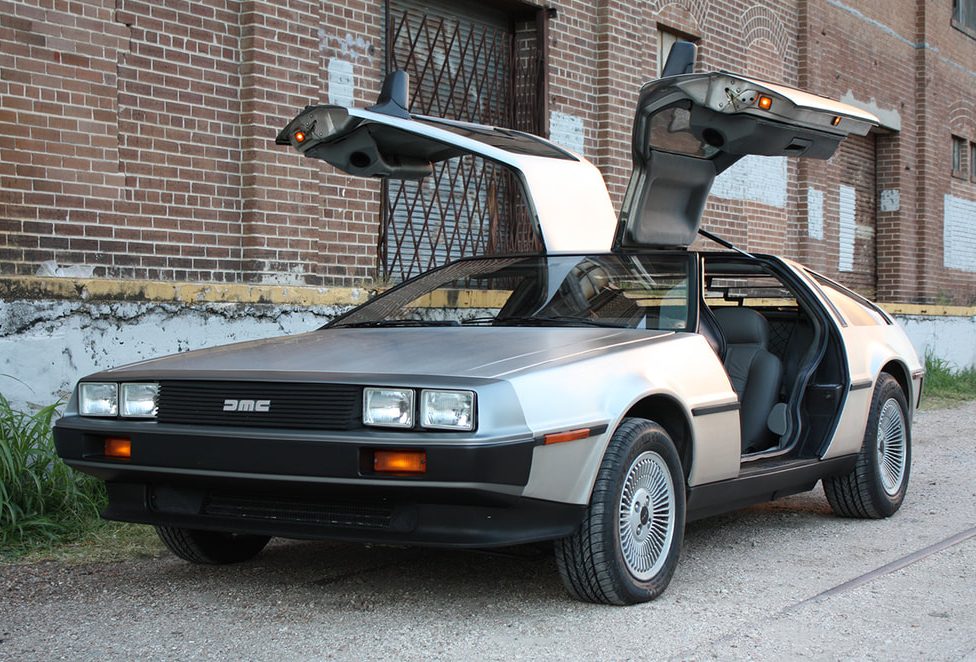
A Potential Explanation
There are other routes towards corrosion for stainless steels, too. One of the most common ways for stainless steel to rust is when it comes into contact with non-stainless steel. For example, using steel wool to clean stainless steel can leave tiny iron particles in the stainless steel which penetrate the passivation layer and enable further corrosion. Another common way it happens is when particulates from welding operations land on stainless steel in a factory environment. Cross-contamination can also occur when tools are used to cut both mild steel and stainless steel components. The presence of non-stainless steel particles can prevent the formation of a passivation layer in a small area, leading to corrosion.
Indeed, it may be iron in particulate form is the cause for the corrosion seen in some of these Cybertruck photos. We see tiny little spots where rust is occurring. These spots may be rail dust, tiny iron particles thrown up from train wheels and rails. Rail dust is a well-known problem in the car detailing community, particularly for people in areas with heavy rail use or for cars that have been transported via rail.
Rail dust can affect any car, but is most visible on light paint jobs. Once the tiny particles land on a vehicle, they can corrode on top of the paint – the problem has been around forever. The usual treatment to remove rail dust from a regular car’s paint finish is to use some kind of detailing product which dissolves the material. The solution is then washed off to avoid any damage to the paint.
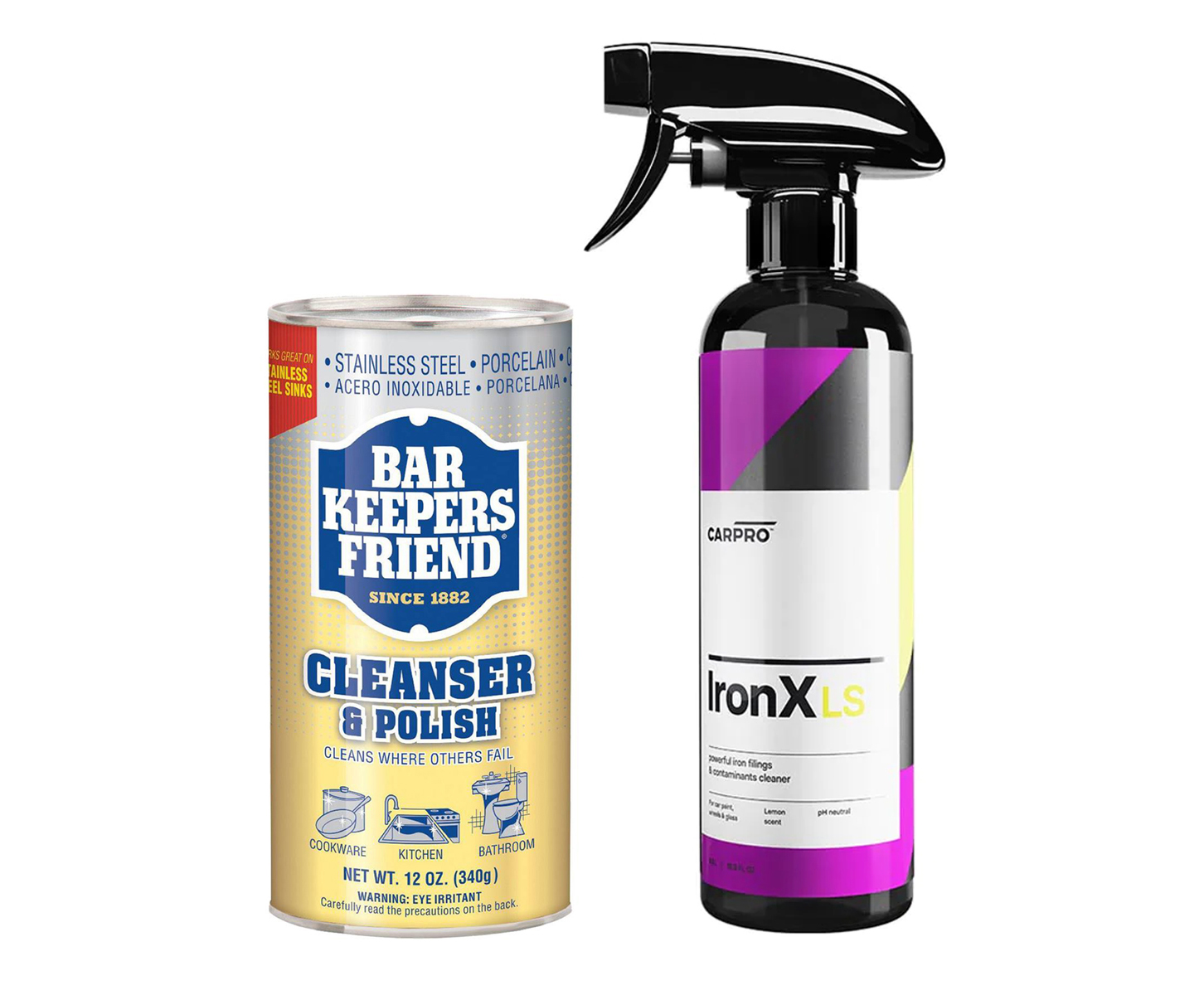
Reports from the forums support the rail-dust hypothesis. Both posters mentioned above found success cleaning off the spots using a product called Bar Keeper’s Friend. It’s a popular product for cleaning stainless steel, particularly in the hospitality industry, and contains three main ingredients. It’s made up of feldspar, likely used as a mild abrasive, sodium dodecylbenzene sulfonate, which is a detergent, and citric acid. It’s the latter that probably had the most beneficial effect on the stainless steel of the Cybertruck, helping to remove any iron contamination on the surface. Once rinsed off, the stainless steel would be able to reform its chromium passivation layer, and the panel would look unblemished once more. That is, as long as the corrosion was treated quickly and not left too long. If corrosion took hold and created deeper pits in the surface, more polishing would be required to get back to a smooth finish.
Both OnTheSnap and vertigo3pc were happy to share their stories with The Autopian, and their photos in turn. Both used Bar Keeper’s Friend to clean their Cybertrucks, with positive results. “I usd the soft liquid variant of BKF,” explained OnTheSnap, adding “After applying it with a sponge I cleaned it off using Windex. He’s had little issue since, too. “It has maintained the same state.” He notes that he has also used the foam spray version of Bar Keeper’s Friend on the whole car since, which brought the shade of the stainless steel up to a lighter color. “So far it’s equivalent to owning a painted car that you wish to maintain, except I use Windex instead of water to quickly clean it” he explains, noting that he follows the typical guidance to remove bird droppings or other contaminants as he sees them.
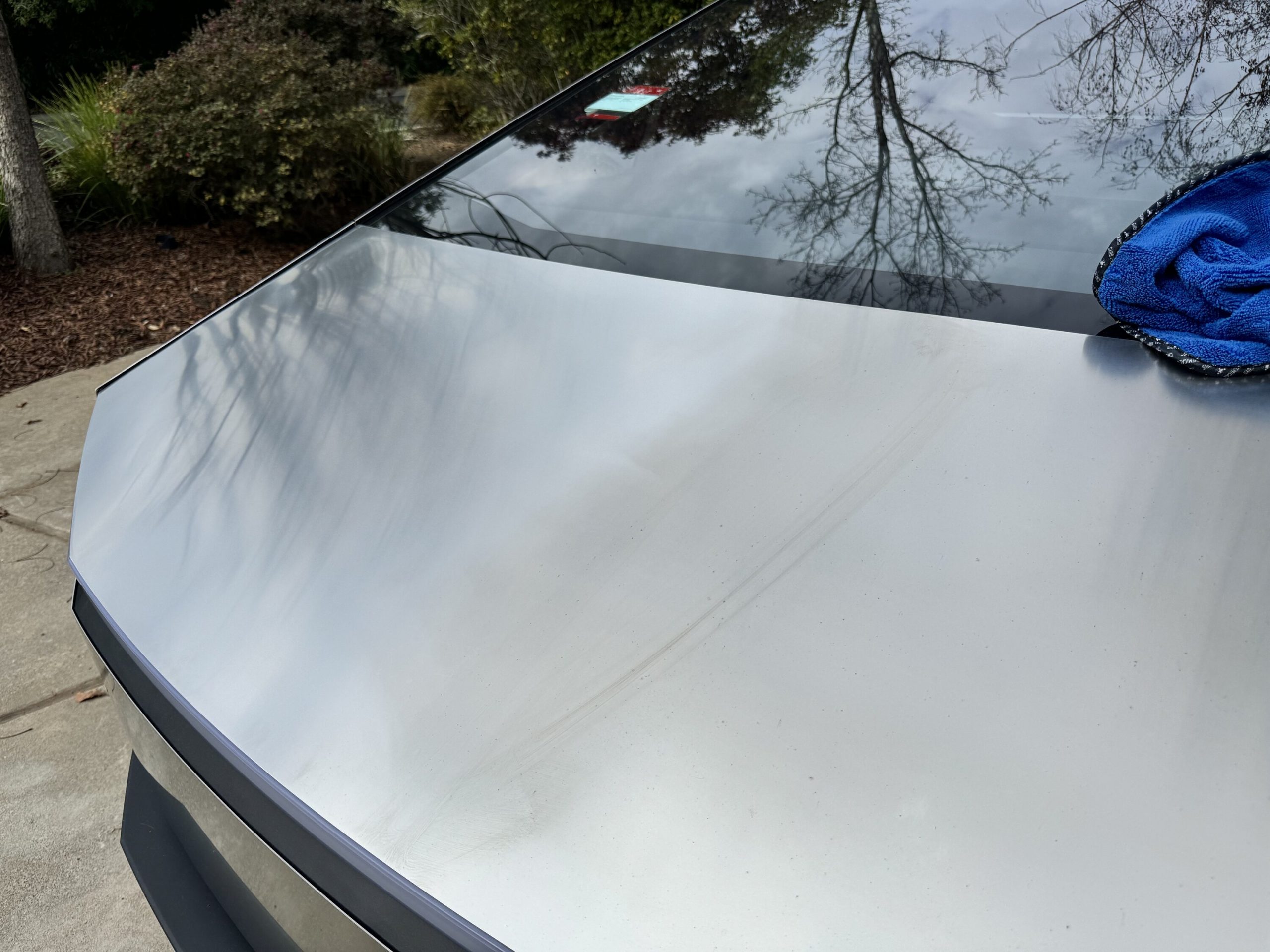

As for vertigo3pc, he had similar success. “I removed the spots using Barkeeper’s Friend (soft version), using a tiny amount on the surface of a microfiber rag, and gently wiping over the spots,” he explains. “I assumed that wiping harder with BKF would definitely remove it, but also just using the rag wet with BKF soft also removed it… so I believed the BKF soft liquid had something to neutralize and remove the spots, whatever they were.” Since the treatment, he hasn’t seen the spots reoccur. He also tried an iron decontamination detailing spray from Chemical Guys, just in case. “After 2 rounds, I noticed no purple runoff, so I assumed the contaminants were gone,” he says.
“I found the best way to remove the spots was Barkeeper’s Friend Soft, followed by soap and water, followed by ammonia-free window cleaner and wipe dry,” says vertigo3pc. He’s contemplating adding a coat of Everbrite ProtectaClear in future to preserve the look of the stainless steel.
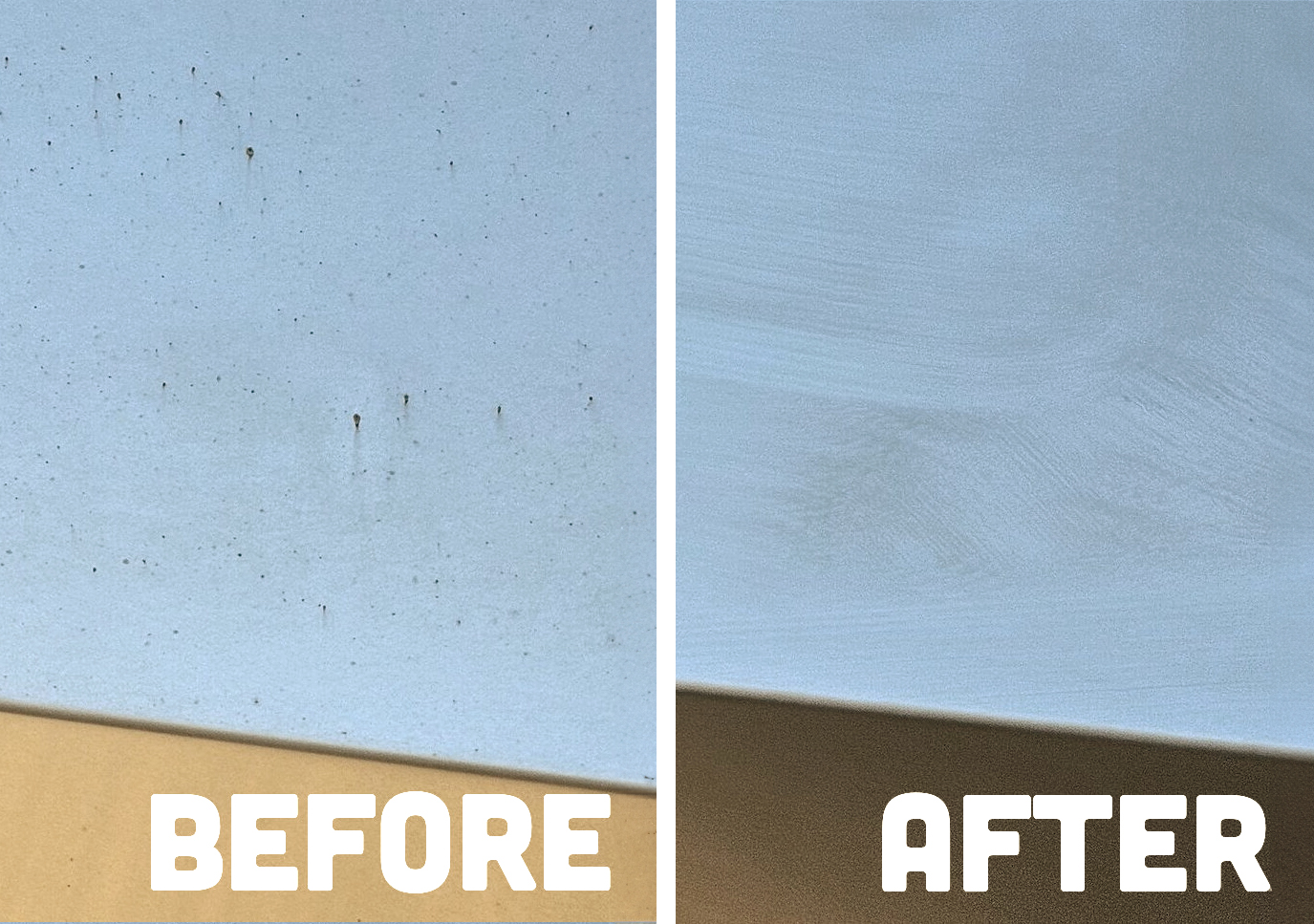
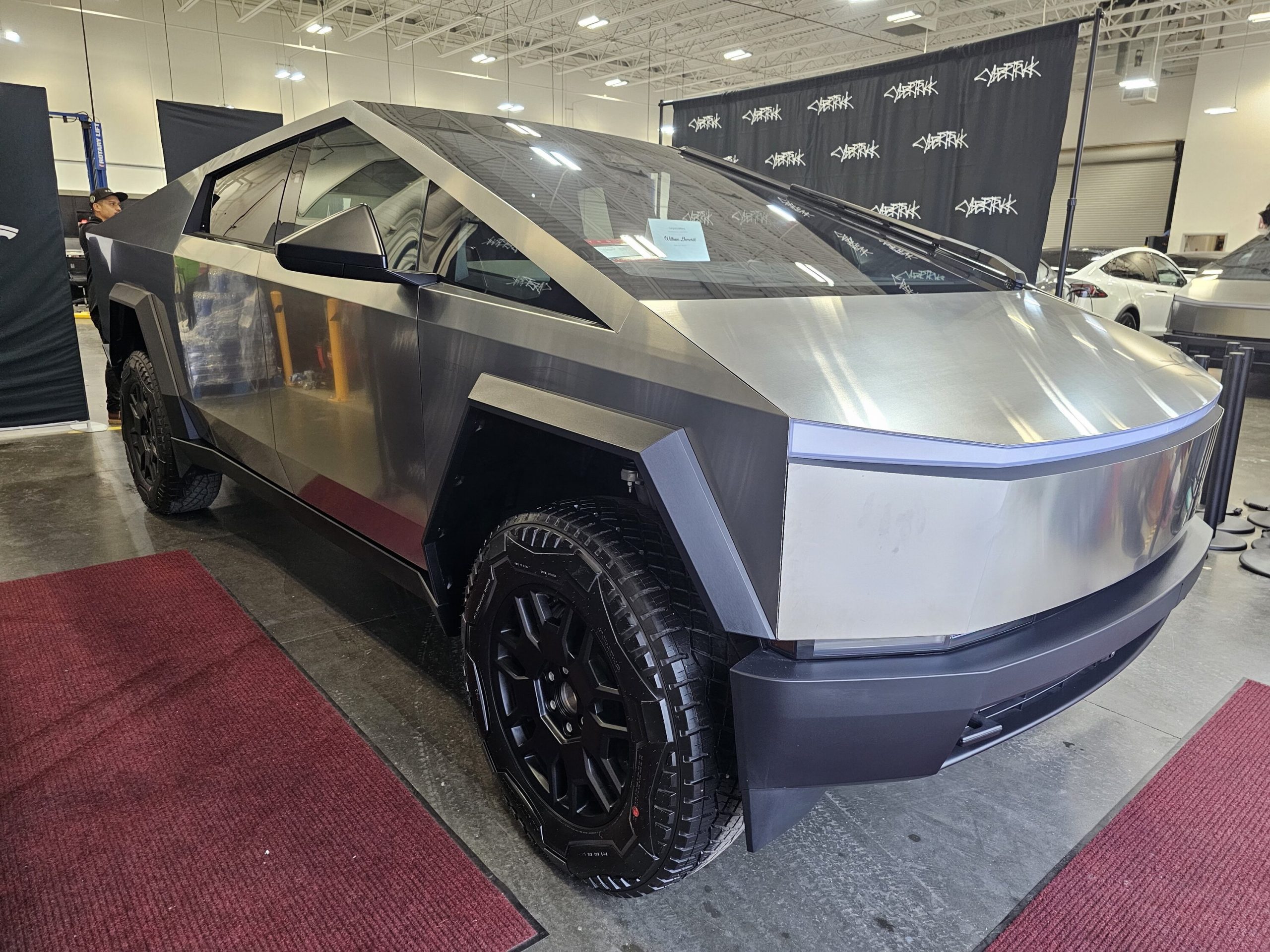
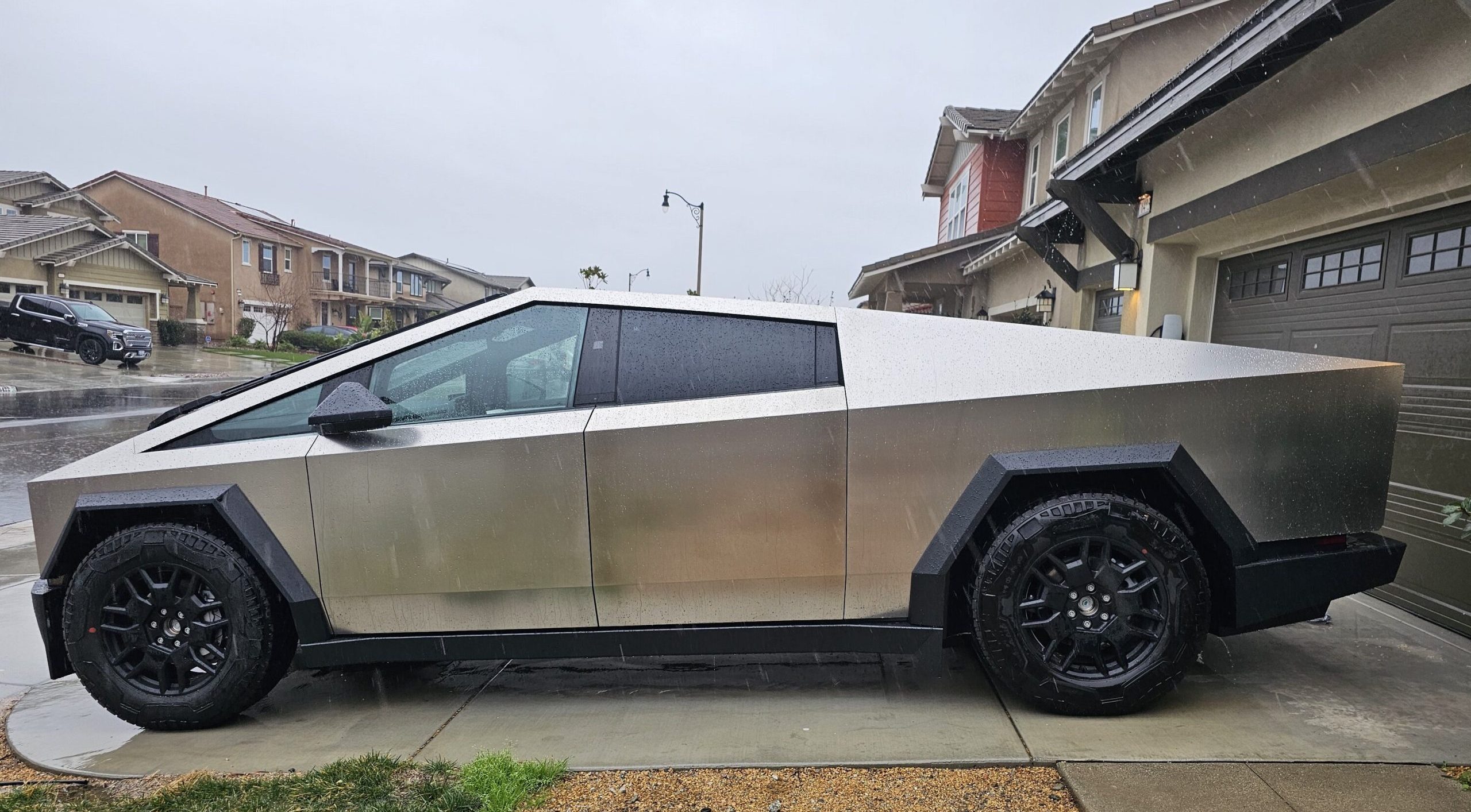
Of course, the corrosion could always reoccur if the trucks were re-exposed to iron contamination. If you lived in an area where iron particulates frequently came down with the rain, you could find yourself detailing the car fairly regularly. Indeed, the Cybertruck manual advises owners to “immediately remove corrosive substances (such as grease, oil, bird droppings, tree resin, dead insects, far spots, road salt, industrial fallout, etc).” At the same time, most automakers make similar suggestions for cars with regular paint finishes, too.
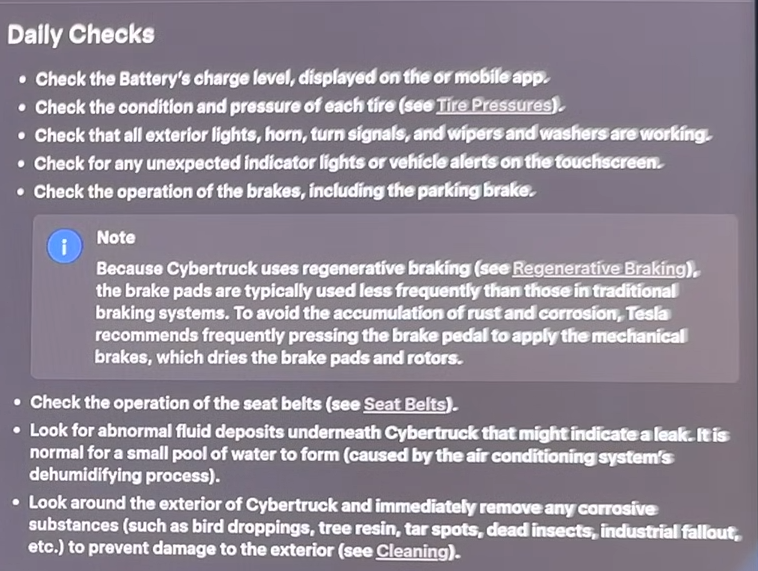

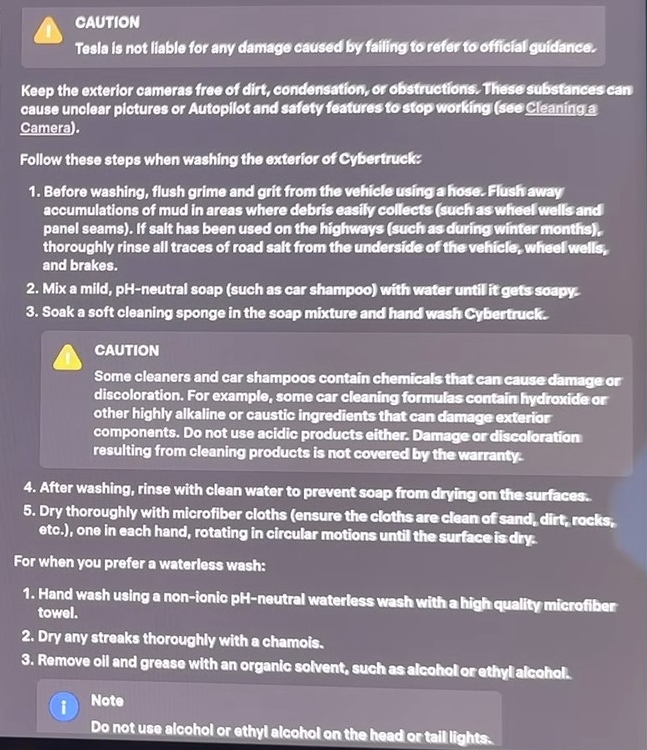

Supporting Evidence
It bears noting that Cybertruck lead engineer Wes Morrill has come out and stated that this type of corrosion is to be expected on the vehicle. On Twitter, he explained that iron particles sitting on the surface of the stainless steel will create corrosion, and that cleaning off with a solution like Bar Keeper’s Friend is recommended.
Good myth busting. Stainless is reactive and free iron that sits on it will rust. It's surface contamination only and can be cleaned off easily. Bar Keeper's Friend used here works well, citrisurf77 can also loosen the deposit and simply wipe it off. If anything stubborn use a… https://t.co/HD3Xeo0inH
— Wes (@wmorrill3) February 16, 2024
You can see Bar Keeper’s Friend in action in a video from Out of Spec Detailing. It doesn’t concern corrosion specifically, moreso how to generally detail the Cybertruck’s stainless steel panels. Regardless, it’s clear to see the effect of the cleaning product on the surface. As a mild abrasive and acidic cleaner, it does a good job of shining up the panels. Presenter Coleton recommends applying it to the entire vehicle to ensure a consistent finish across the truck.

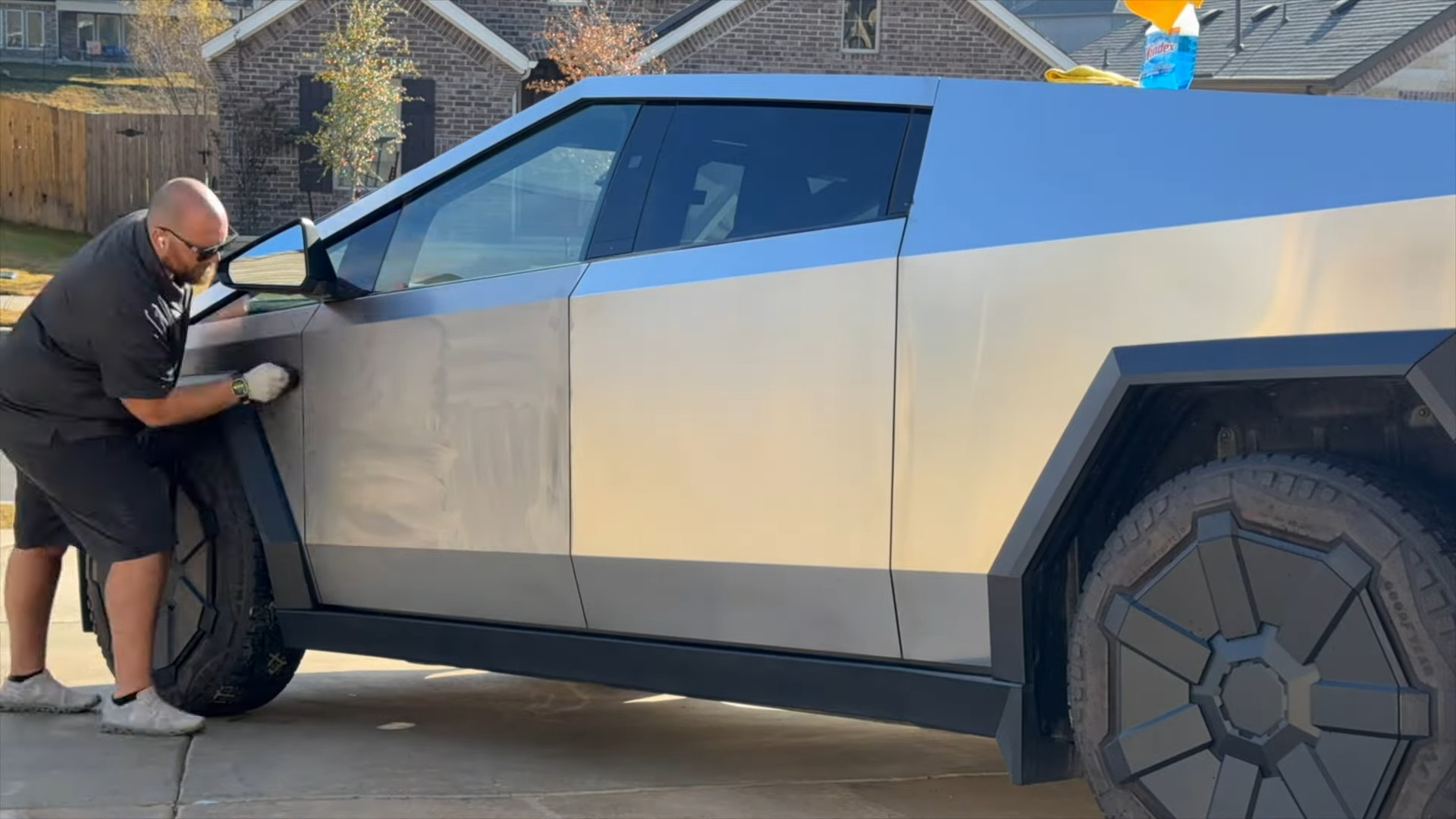
Lots of Cybertrucks, near the delivery center in Austin TX
byu/GunGeekATX incybertruck
There is a large variation in color between panels on new Cybertrucks seen in many photos. One wonders whether a full-car detail could sort this out, or if it’s happening in pre-delivery.
Cold, Hard Reality
So, we’ve learned that stainless steel can indeed corrode, and the conditions under which that can happen. However, for now, it’s really too early to tell if the Cybertruck has a real corrosion problem. If you live right next to a railway, or you regularly transport your car via train, then yes, I’d suspect you might have some corrosion issues to deal with on the regular. Outside of that, it’s probably too soon to tell. Unless Tesla shares its alloy composition with us, or shows us the results of exposure tests that it ran on real panels, we won’t know for some time.
Ultimately, it could prove frustrating for some owners in areas where this kind of contamination is common. Nobody wants to be spending every weekend detailing their truck to avoid unsightly corrosion. While iron particulate contamination can stick in a regular clearcoat and appear ugly, you can at least rest relatively easy in the knowledge that it’s not going to cause too much problem for the metal underneath the paint. In the case of the Cybertruck, there is zero protective layer, so anything on the surface is interacting with bare metal. We should know in the next few months just how much of a burden—or not!—this will prove to be for Cybertruck owners. It may just be the case that a rub-down with Bar Keeper’s Friend once every month or two is enough.
If I had a Cybertruck, I’d be looking to the community to see what works and what doesn’t. I’d absolutely avoid using any steel wool or other iron products on the vehicle, and I’d try and keep the car parked somewhere where it’s not going to be exposed to contaminants like bird droppings or leaf litter. That’s just good practice for any car, though. I’d stop short of personally supporting the use of Bar Keeper’s Friend, having not tried it myself. It makes sense, but I’d hate to see anyone ruin their vehicle. Whatever you do, this sage advice always rings true: “Test on an inconspicuous area first.”
I hope this article has enlightened you to the magic (and limitations) of stainless steel. We might not have all the answers yet, but the science can point you towards the right (and wrong) things to do when it comes to taking care of your stainless steel vehicle. If you’ve got your own Cybertruck, reach out to us for a chat—we’d love to get more word about what’s happening on the ground!
Image credits: Tesla, Out of Spec Detailing via YouTube screenshot, Bar Keeper’s Friend, Carpro, Jason Leung







Just curious if this is included in the Chromium ban in CA by 2030 (Probably not since it’s a little bit added in and it’s not “decorative”) I’d rather have a Delorean anyway
Looks like that’s specific to hexavalent chromium ions. Elemental chromium alloyed in stainless should still be fine, though I think ore processing may be harder. Probably makes the process of chrome plating difficult to impossible, but the end result should still be legal.
I’d just let it patina
So I looked, and you can polish stainless steel to a mirror shine just like I polish my semi trucks aluminum tanks. And it has been done on a DeLorean. So it’s a solution to the rust problem. Just wait until some Youttubeboob figures it out…
Honestly surprised this didn’t happen week 1
Rail dust is a thing! My 2013 automobile started showing rust on the wheels mere weeks after purchase. My tired brain dragged it to the dealer where several people, some in coveralls and some in white shirts, scratched their heads for an hour and a half.
They told me it was iron dust, and that my wheels are cast aluminum. DUH!!! Why didn’t ALL of us figure that out immediately! (I blame time change on my muddled brain at the time.) A quick polish and I never looked back.
I’m sorry it is steel that is stainless not stained less. At 6 figures the vehicle should not be developing rust in 5 days of normal use. If as is likely it is due to transport by rail dealer prep should be required to remove the iron particles. Let it be written, let it be done
As much as I’m happy to hand-wash a roadster every few weeks, the sheer square footage of a Cybertruck’s body makes the task sound downright daunting. I suppose there aren’t a whole lot of nooks and crannies to slow one down, but having to scrub those gigantic panels while following the grain would drive me crazy. On the plus side, there’s no roof panel to clean, so the operation can be completed without a stepladder. I’d be worried about any internal contamination, inside sills and wheel wells where one might not see and/or reach iron dots for cleaning. Are these things sealed from the inside? Do they paint or otherwise coat the back of the panels? I hope so.
Great article!!! Very well done. My wife has used BKF for 45 years, and it’s great stuff.
Not to be an asshole here, but why even put up with this rusting shit in the first place?
Maybe there’s a good reason the other manufacturers cover their bodies with paint?
I still think stainless is just another of Turdboy’s weasel marketing tricks. And a half assed way to produce a vehicle, whilst the rest of the world does it in a different way.
Thanks for some great info, and explanation.
Thank you! Engineering degree always pays off
I wish I could say I can’t believe people are buying these. I can believe it, it just makes me very, very disappointed in them.
I can’t wait for someone to fully polish their Cybertuck to a mirror shine.
Back in the early ‘oughts, I wanted to replace my CJ7’s body tub with a stainless steel one in Mexico and pay some pesos to get it buffed to mirror brightness. Alas, I didn’t have the money to pay for the trip and the tub.
Let it rust and apply Owatrol.
Cybertruck: Plenty of room for your family in the front and your insecurity in the bed…now with a finish that’s as fragile as your ego!
All we know is that CEO Elon Musk described it as a “ultra-hard 30X cold-rolled stainless-steel.”
Is this the same guy who said the glass was shatter proof? The same guy that said FSD would be out next year (for 10 years running)? Not sure he’s a reliable source about the location of his own ass..
Shatterproof is not the same as unbreakable. There is no proof of shattering.
OK I retract that, but the FSD and finding his own ass still stand
I was using the stainless argument the article had. He’s a dick bit no worse than the other manufacturers
He’s a con man and always will be. Successful at it yes, but still just that.
What a complete and total Diva. These vehicles sounds like dating Sally (as in Harry, not Torchy).
Can you get AV plates and insurance from the start because you only drive it on sunny Sundays?
Garage queen. Etc.
Owning a stainless-steel vehicle sounds like a nightmare. An occasional three-minute $20 car wash is enough to keep my cars looking nice. Having to hand wash a car with a special product every 1-2 months is way more effort than I am willing to go through (assuming that is even adequate). I guess wraps are an option, but those don’t last long and aren’t cheap.
I suspect a lot of Cybertruck buyers will end up regretting their purchases due to the care and expense required to keep this vehicle looking nice. Stainless steel was probably not a great idea.
Interesting conclusion to come to. Having to hand wash the car exactly once with a common kitchen cleaner seems like a very reasonable amount of effort.
It is fine with me if you want to hand wash your car every month with a kitchen cleaner – I know that level of required effort is perfectly acceptable to a lot of people. I personally don’t want to go through any more effort than an automatic carwash every month or so. That is all I do to maintain the appearance of my vehicles, and my vehicles generally retain their factory appearance for years.
I am guessing Tesla does not inform buyers of this maintenance requirement before selling them Cybertrucks, so a subset of buyers is going to be upset.
I have no idea whatsoever where you got this “once a month” idea.
This article makes it pretty clear that the rusting is due to iron dust from shipping, and that unless something gets iron dust on the pickup again, you will not need to clean it again.
Its a pickup, it is going to get iron dust on it from job sites, parking near rail sidings, and the like
Its hilarious that you think a single Cybertruck will ever be used near rail sidings. Or used at a job site.
“We should know in the next few months just how much of a burden—or not!—this will prove to be for Cybertruck owners. It may just be the case that a rub-down with Bar Keeper’s Friend once every month or two is enough.”
I was going with Lewin’s thought that this wash might be needed regularly. I don’t know if this kind of wash will be required on a monthly basis, but I would be very surprised if this was only required once after transport. The conditions that cause this appearance are greatest during rail transport but are presumably encountered during normal driving.
Buying the first run of an experimental vehicle from a company known for rushing products and poor quality control….they should be happy it has four wheels.
Wasn’t the Cybertrucks launch motto “Four more years?”
Maybe not. I got a first run Model 3 performance and it’s been trouble free for 5 years. Contrast that to our ’21 F-150 Powerboost, which has 6 weeks of shop time so far and non of those issues are with the hybrid system. So your point is?
My point is fully explained in my comment, no need to get insulted.
“At the same time, most automakers make similar suggestions for cars with regular paint finishes, too.”
This is true, but I don’t recall any other automaker touting their vehicle as an apocalypse-proof, river-crossing, impossible-to-kill monster machine.
Well as long as you don’t drive it or leave it outdoors.
Just wash regularly with a strong bleach solution, the problem will be gone in no time!
(For anyone not picking up on the sarcasm, do NOT use bleach on stainless steel)
I saw my first two Cybertrucks in the wild over the weekend and good Lord, just no. When I see the compromised headroom over the rear passengers, the incredibly high sides of the bed, the tonneau cover that looks like it will break within a year, the shortish bed (also a problem for many other trucks, admittedly), and the so-so ground clearance I have to admit – I just don’t get it. Then again I’m old school and think a proper pickup is a single cab with an 8-foot bed so I’m just not up with the modern times.
The 6′ bed is above average for minivan pickups in 2024. A lot of the competition has 5.5′ beds.
It also has really good ground clearance, at least aired up, and I don’t think the rear headroom is bad as much as the front headroom is extra high.
How much of that 6′ is usable though? From the pictures I have seen the angles of the sides and general shape have it at much less than that.
I understand the front of the bed slopes in significantly, so only the bottom is 6′, so it’s big enough to carry plywood and lumber flat but not taller things. I imagine at the top of the slope it’s still at least as big as a 5.5′ Ford bed.
the 5.5 beds are colorado/rangers. much smaller wheel base.
Also on most of the highline F-150’s, and no rear steering to mitigate the wheelbase.
Except for how Ford, Chevy, and Dodge all sell half ton pickups with beds shorter than 6 feet. The Chevys and Dodges are in between 5.5 and 6 feet.
5’5″ is for full size crew cabs, the extended/quad cabs are usually just over 6′ 7″
Good article, Lewin. It’s a good general explainer for the science and chemistry involved with this. It reminds me of the days when I was a commercial brewer. At a minimum 304 SS is used for equipment, but some could be had in 316 SS if you could stomach the price. A brewery is a very aggressive environment for stainless steel. High humidity, both caustic and acidic agents being used, sticky sugars from wort, alkalinity from hops, chlorides used in water treatment, and things of that nature. We would have re-passivate the equipment with Nitric acid every 6 to 12 months, depending on use. Even then, you may find yourself busting out the BKF (I used a mixture of liquid and granular) to clean up surfaces occasionally.
I’m gunna go out on a limb here and say that this is off-the shelf stuff. Nobody is rolling special mixes at the plant for a small user like Tesla. Also, not unusual for surface contamination to ruin a stainless finish. The issue compared to paint is that you can’t just refinish it so you absolutely have to catch it before it gets too bad. Otherwise the best you can hope for is a new part but even then, matching the grain is not likely.
Small user like Tesla? You’ll recall that the Model Y is one of the best selling cars in the world, and they have lofty sales goals for the Cybertruck.
The model Y does not use sheet stainless.
“Lofty goals” won’t convince US Steel to change their process for a specialty mix of stainless.
Yes, Tesla is a very small user of sheet stainless. The entirely of automotive is about 10% of sheet stainless. And most of the heavier guage stuff is commercial. More sheet steel goes into stainless dump beds or snow plows then however many dozens of CyBeTrUcKs are built.
I bet higher quality stainless is available without custom mixing. Just got too pay premium.
You forget that SpaceX uses stainless too. That’s where they went for help on this alloy, and I’m pretty sure it gets factored into discounts.
Much like the recent titanic submarine guy he used used and inferior materials for construction and was crushed.
I mean technically you could use Nitric acid or just rub an Orange on it as Citric acid is the more EPA friendly acid that will remove oxidation and then leave a passivated surface. But it has to be done early on as extensive corrosion is hard to remove and treat properly. And you cannot really passivate all portions of the panels once installed.
Though it does seem like misstep not to electropolish the parts before installation, that is generally far superior than pickling or passivation in the end.
Even stainless steel knives and forks have had nickel added for years to stop rusting. You have to be a real cheap skate to buy the non-nickel stuff (you can tell the difference because the nickel alloy does not react to magnets) which rusts and stains quickly…
Just needs some Rust-eze medicated bumper ointment, and it’ll be good as new.
400 Grade is often the really shiny stainless and also used a lot in ship air dampers for the perception of being corrosion resistant but it often gets the little rust specs pretty quick when it hits saltwater. 300, as you note is also somewhat problematic with salt water.
I imagine Midwest salt slush will make for a pretty ugly Rustertruck quickly. I am a little surprised he is not requiring a passivation step or a sealer of some sort to avoid the future warranty cries.
Tesla seldom considers the fact that cars exist outside Southern/Bay Area California and Texas.
How about Corten steel instead?
But then people might mistake your cybertruck for a self propelled shipping container.
I think that would be infinitely more useful than this abomination, as long as it stays off of public roads of course.
While people love the Tesla hate train this was good information to counter the FUD. I just could not buy this and not at least wrap it with PPF so I would not have to deal with constant fingerprints.